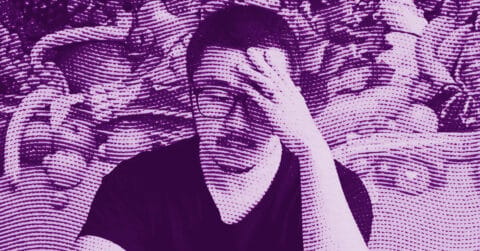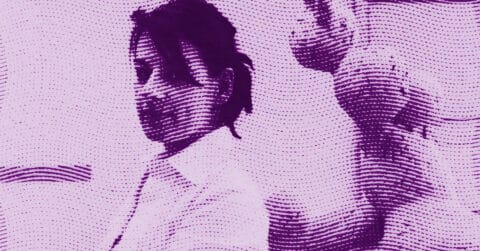Listen to me carefully, you bunch of snobs, Chloé Wise (born in 1990) perfectly embodies the artist who knows how to transform our consumer society into a theater of the absurd, while maintaining a remarkably sharp critical distance. This Canadian based in New York deploys a creative arsenal that oscillates between oil painting, sculpture, and installation, creating a universe where laughter meets the sharpest reflection on our era. Her work, deeply rooted in our time, dissects with surgical precision the mechanisms that govern our social relations and our relationship to consumption.
Two main themes emerge in her work with striking clarity. The first concerns her unique way of approaching consumerism and its codes, notably through an exploration of the relationship between food and desire. Her sculptures of bags shaped like bagels or baguettes, such as her famous “Bagel No. 5” (2014), are not mere provocations. They fit within a philosophical tradition tracing back to Jean Baudrillard and his theory of simulacra. Baudrillard, in “Simulacra and Simulation” (1981), developed the idea that our contemporary society has substituted real signs for the real itself. Wise’s works perfectly illustrate this theory by creating objects that are both simulations of luxury goods and representations of food, thus blurring the boundaries between the edible and the commercial, between the authentic and the artificial.
This approach finds a particular echo in her more recent installations, such as the series of chandeliers shaped like Caesar salad, where the fake becomes truer than nature, creating what Baudrillard called hyperreality. These sculptures are not simply sophisticated trompe-l’oeils; they question our relationship to authenticity in a world where the line between true and false becomes increasingly porous. The drops of dressing that seem to bead on the lettuce leaves of her luminous installations create a fascinating tension between the perishable and the eternal, between the utilitarian and the artistic.
The second theme of her work lies in her approach to contemporary portraiture. Wise revisits this traditional genre with a particularly keen insight, integrating the visual codes of the digital era. Her portraits are not mere representations of people but deep explorations of how we stage ourselves in the age of social media. This approach echoes Roland Barthes’s reflections in “Camera Lucida” (1980) on photography and how we construct our image. Barthes spoke of the “punctum,” that element in an image that points to us and touches us personally. In Wise’s work, this punctum is often found in the slightly offbeat expressions of her models, in those smiles that seem both authentic and artificial.
The way she paints her friends and acquaintances, often with everyday consumer products as props, creates a fascinating tension between the intimate and the commercial. These portraits are reminiscent of 17th-century Dutch still lifes, where everyday objects were laden with deep symbolism. But in Wise’s work, the symbols belong to our era: dairy product packaging, well-known brands, everyday objects elevated to the status of icons. Her painting technique, inherited from the great masters but applied to contemporary subjects, creates a fascinating dialogue between tradition and modernity.
In her latest works, notably those presented in the “Torn Clean” (2024) exhibition, Chloé Wise pushes her reflection on human vulnerability and our ways of masking it even further. The introduction of bandages in her portraits creates a new layer of meaning: these medical accessories become metaphors for our fragility and our constant need for repair. The manic smiles of her subjects, combined with these discreet bandages, tell a story of forced resilience, of that social obligation to “put on a brave face” despite our wounds.
Her use of color deserves special attention. The flesh tones she employs, sometimes called “piglet” in her paint tubes, create a tension between the sublime and the abject. This approach recalls Julia Kristeva’s theories on abjection in art, where the beautiful and the repulsive coexist in a complex dance. The monochromatic backgrounds of her recent portraits, often close to the skin tones of her subjects, create a subtle camouflage effect that enhances the feeling of an identity in dissolution.
Wise navigates different registers without ever falling into pure cynicism. Her humor acts as a Trojan horse, allowing deeper questions about our era to be introduced. She manages to maintain a delicate balance between social critique and a form of empathy for her subjects, thus creating an art that is neither completely accusatory nor totally complacent.
Her work on smiles, in particular, deserves close attention. In a society where smiling has become a form of social currency, Wise makes it an anthropological subject of study. Her portraits capture that strange temporality of the posed smile, the one that lasts too long to be natural. This exploration echoes Baudrillard’s observations in “America” about the American smile as a form of codified communication. Wise’s subjects seem aware of being watched, their expressions oscillating between the authentic and the performative.
The artist does not merely critique this social performance; she also reveals its strange beauty and necessity. Her recent portraits, with their exaggerated smiles and discreet bandages, tell the story of our collective resilience, our ability to keep smiling even in adversity. Perhaps this is the greatest strength of her work: in her ability to transform our mediated daily life into a form of contemporary visual poetry.
Her approach to fame and artistic recognition is particularly interesting. Since the buzz created by her “Bagel No. 5” worn at a Chanel event, Wise has skillfully navigated the art world with remarkable intelligence. She uses the very mechanisms she critiques, social networks, influencer culture, luxury marketing, to spread her work. She creates pieces that function both as social critiques and objects of desire. Her paintings and sculptures, while pointing out the excesses of our consumer society, become coveted collectible objects themselves. This irony is not lost on the artist, who makes it an element of her reflection on how art circulates and gains value in our society.
The performative dimension of her work extends beyond canvas and sculpture. Her installations create immersive environments that transform the exhibition space into a stage where the theater of our daily consumption plays out. The blocks of butter slowly melting on their glass pedestals in her recent exhibitions create a temporal tension that forces the viewer to confront the ephemeral nature of our desires and possessions.
Her use of the traditional medium of oil painting to depict our hyperconnected world is no accident. This technique, historically associated with aristocratic portraits and sumptuous still lifes, becomes in her hands a tool to document and question our new social rituals. The technical virtuosity she deploys serves to represent seemingly mundane moments, someone drinking almond milk, a friend posing with wireless earbuds, transforming these everyday instances into paintings that merit the same attention as 17th-century vanities.
The pandemic has added a new dimension to her work, notably in her approach to indifference as a survival mechanism. In a world saturated with traumatic information, her works explore how we manage to maintain a facade of normality. Her portraits from this period capture this strange duality: the acute awareness of disaster and the need to continue functioning normally. The bodies she paints, often nude but never vulgarized, also bear the marks of our era: tattoos, piercings, technological accessories. These elements become temporal markers that anchor her works in our present while giving them a potential archaeological dimension.
She reserves a very particular treatment for everyday objects. Her contemporary still lifes, populated with everyday consumer products, transform these objects into relics of our time. A milk carton becomes a cultural artifact, a bandage becomes a symbol of our collective vulnerability. This approach recalls the tradition of vanities, but updated for our era of overconsumption and planned obsolescence.
The influence of digital technology on her practice is particularly visible in her way of composing her images. Her framing, often inspired by the codes of selfies and social media photos, creates a dialogue between the tradition of painted portraits and new forms of self-representation. This hybridization of visual references produces works that function both as sociological documents and as autonomous aesthetic objects.
Her work on materiality is particularly fascinating in her sculptures. The use of urethane and oil paint to create hyperrealistic simulations of food raises fundamental questions about our relationship to reality in a society where the virtual increasingly occupies space. These works are not simply sophisticated trompe-l’oeil; they challenge our ability to distinguish true from false, natural from artificial.
The political dimension of her work, although never didactic, is manifested in her way of addressing issues of gender and identity. Her portraits of women, in particular, deconstruct the codes of female representation in art. The sometimes grotesque or unsettling expressions of her female models defy the conventions of beauty and docility traditionally associated with portraits of women.
Wise manages to create art that speaks deeply about our era while avoiding the pitfalls of simplistic social commentary. Her work is complex precisely because it rejects easy moral positions. She shows us our world in all its absurdity, beauty, and horror, leaving us free to navigate between these different interpretations.
Chloé Wise’s work constitutes a complex and nuanced commentary on our era, where the authentic and the artificial constantly blend. She manages to capture the essence of our ambivalent relationship with consumption, self-representation, and technology, while creating works that remain deeply human in their approach. Through her critical yet empathetic gaze, Wise offers us a mirror of our society, but a mirror that does not merely reflect: it reveals, questions, and transforms our perception of reality.
















